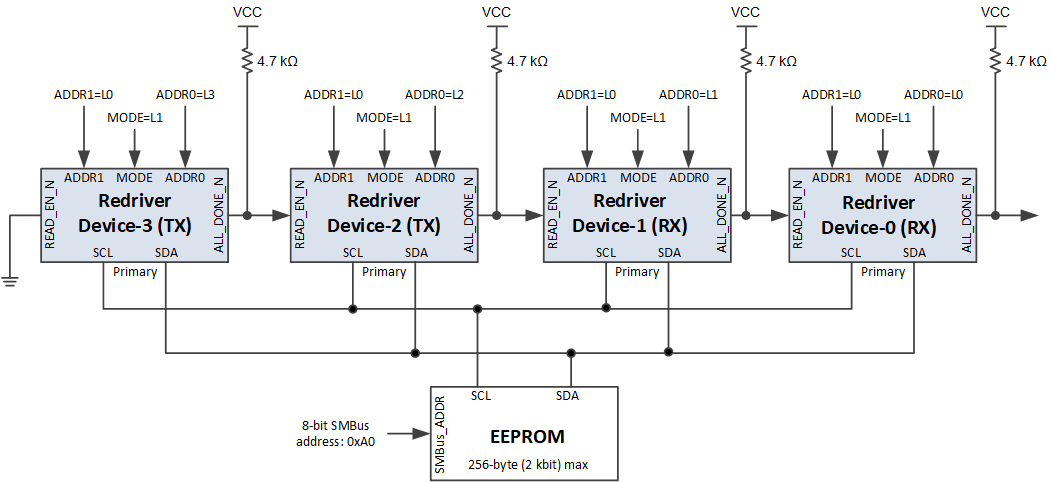SNLS714 September 2022 DS320PR822
PRODUCTION DATA
- 1 Features
- 2 Applications
- 3 Description
- 4 Revision History
- 5 Pin Configuration and Functions
- 6 Specifications
- 7 Detailed Description
- 8 Application and Implementation
- 9 Power Supply Recommendations
- 10Layout
- 11Device and Documentation Support
- 12Mechanical, Packaging, and Orderable Information
7.5.3 SMBus/I2C Primary Mode Configuration (EEPROM Self Load)
The DS320PR822 can also be configured by reading from EEPROM. To enter into this mode MODE pin must be set to L1. The EEPROM load operation only happens once after the device's initial power-up. If the DS320PR822 is configured for SMBus Primary mode, then it will remain in the SMBus IDLE state until the READ_EN_N pin is asserted to LOW. After the READ_EN_N pin is driven LOW, the DS320PR822 becomes an SMBus primary and attempts to self-configure by reading the device settings stored in an external EEPROM (SMBus 8-bit address 0xA0). When the DS320PR822 has finished reading from the EEPROM successfully, it will drive the ALL_DONE_N pin LOW. SMBus/I2C secondary operation is available in this mode before, during, or after EEPROM reading. Note: during EEPROM reading, if the external SMBus/I2C primary wants to access DS320PR822 registers, then it must support arbitration.
When designing a system for using the external EEPROM, the user must follow these specific guidelines:
- EEPROM size of 2 kb (256 × 8-bit) is recommended.
- Set MODE = L1, configure for SMBus Primary mode.
- The external EEPROM device address byte must be 0xA0 and capable of 400 kHz operation at 3.3 V supply
- In SMBus/I2C modes the SCL and SDA pins must be pulled up to a 3.3 V supply with a pull-up resistor. The value of the resistor depends on total bus capacitance. 4.7 kΩ is a good first approximation for a bus capacitance of 10 pF.
Figure 7-2 shows a use case with four DS320PR822 to implement a 2x2 cross point for x8 PCIe configuration, but the user can cascade any number of DS320PR822 devices in a similar way. Tie the READ_EN_N pin of the first device low to automatically initiate EEPROM read at power up. Alternatively, the READ_EN_N pin of the first device can also be controlled by a micro-controller to initiate the EEPROM read manually. Leave the ALL_DONE_N pin of the final device floating, or connect the pin to a micro-controller input to monitor the completion of the final EEPROM read.
 Figure 7-2 Daisy Chain
Four DS320PR822
Devices to Read from Single EEPROM in 2x2
x8 Configuration
Figure 7-2 Daisy Chain
Four DS320PR822
Devices to Read from Single EEPROM in 2x2
x8 Configuration